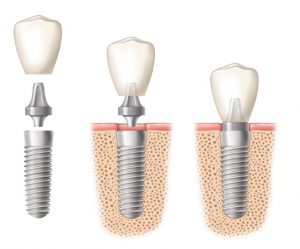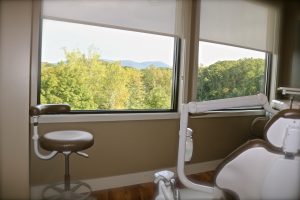Header logo
header top contact widget
Dental Technology
Missing Teeth Should Be Replaced For The GOOD Of Overall Well-Being.
Posted on Oct 22, 2019 by William J. Claiborne, DDS MS
Sometimes, it’s what we can’t see that can do the most harm.
A surprising example of that is wearing dentures. While dentures and partial dentures do replace the presence of teeth, they actually have a detrimental effect on what lies beneath.
If you remove your denture, you can actually SEE what’s going on.
For people who have worn dentures or partials for ten years or more, the appliance has applied pressure to the bone ‘ridge’ that once supported natural teeth. And, without the stimulation of tooth roots in the bone, the jaw begins to decline in mass.
Without the denture in place to “fluff up” the shape of the mouth, a look in the mirror can reveal signs of bone loss. These include:
- Deep wrinkles around your mouth.
- The corners of your mouth turn downward, even in a smile.
- The mouth seems sunken in. Jowls have formed on the sides of the face.
- The chin seems more pointed than in your youth.
- The chin may also seem closer to the nose.
This decline in bone occurs when a tooth root is removed from the jaw bone. Without natural tooth roots to nourish and stimulate the root, the process of ‘resorption’ begins.
Additionally, resorption increases risks for tooth loss to neighboring natural teeth. As the jaw bone declines in an area to adjacent tooth roots, these teeth are more vulnerable to cavities, gum disease, and fractures.
It is a fact that when a tooth is lost, the one next to the one missing is most likely the next to be lost.
For people who opt to replace a tooth (or teeth) with a crown-&-bridge, they can also expect bone loss. Over time, this is visible by a gap that seen between the base of the bridge and the natural gum tissues.
As a periodontist, the most common complaint I hear from those who wear dentures or partials is having discomfort while eating. Many long-time denture and partial wearers experience sore spots on tender gum tissues. This occurs because their appliances move when chewing certain foods.
This movement is the result of the declined bone mass that supports the denture. This gum-covered ‘ridge’ where teeth were once held flattens as the jaw bone declines in height and mass. Because a denture or partial is made to contour to this ridge, it begins to slip as the bone shrinks. This is when people tend to use denture adhesives and pastes more frequently.
To avoid discomfort when eating, denture wearers begin to alter their food selections, opting for soft foods that dissolve quickly in the mouth without having to chew. In many cases, these choices lack the fiber, vitamins, minerals and protein needed for proper nutrition.
To no surprise, denture wearers are known to take more medications and have more gastrointestinal problems than non-denture wearers. Yet, the problems of “slippery” or “wobbly” dentures can affect social involvement as well.
Due to fear of embarrassing slips, denture wearers begin to decline social gatherings where food is the centerpiece. Social involvement is a healthy part of keeping our brains and bodies active, which is a positive part of aging.
It stands to reason that there is a need to replace more than the mere presence of teeth. This is why so many dentists and dental specialists now recommend dental implants. For decades now, they have been a dependable option to replace missing natural teeth.
There are many advantages to dental implants. From a health standpoint, I see their ability to halt bone loss as a leading benefit. Dental implants are placed in the jaw bone, recreating the stimulation of tooth roots. This helps to preserve the strength of the jaw bone while restoring biting strength and chewing stability.
I also like that dental implants are self-supporting since they use the jaw bone for support. They do not rely on having otherwise-healthy, natural teeth crowned for the mere purpose of supporting replacement teeth (as in crown-&-bridge combinations).
From a value perspective, dental implants are an excellent investment. With proper selection, placement and care, they are designed to last your lifetime. And, it’s an investment you’ll enjoy every day as you comfortably eat foods you love, smile and laugh without worry, and wake up with a smile!
There is much to know as to why keeping your natural teeth is so important. However, when tooth loss does occur, you can protect your health and well-being by replacing them with implants. With dental implants, you are able to avoid the long-term repercussions of bone loss.
When extreme bone loss has occurred, we can restore bone mass through several methods. One uses a bone-rebuilding material that generates new growth. For some patients who have lost bone due to gum disease, our Asheville periodontal dental office also offers LANAP technology (Laser-Assisted New Attachment Procedure). This advanced technology has been found to stimulate bone regrowth in damaged areas.
Ask about dental implants to restore a natural look and feel while you protect surrounding teeth and bone structure. As a periodontist with advanced training in the diagnosis and placement of all types of implant systems, I can recommend options that will work best for your individual situation.
Call 828-274-9440 to learn more or ask for a consultation to personally discuss your needs and preferences.
Men Have Greater Risks For Dental Problems.
Posted on Aug 20, 2019 by William J. Claiborne, DDS MS
Research has found that periodontal disease is higher in men (56.4 percent) than in women (38.4 percent). https://www.perio.org/consumer/gum-disease-and-men
 The reason for this significantly higher number may be due to some findings revealed through some unsettling findings. According to a survey by the Centers For Disease Control & Prevention (CDC), only 66 percent of males brush their teeth twice or more a day compared with 86 percent of females who do so.
The reason for this significantly higher number may be due to some findings revealed through some unsettling findings. According to a survey by the Centers For Disease Control & Prevention (CDC), only 66 percent of males brush their teeth twice or more a day compared with 86 percent of females who do so.
This was revealed through a study of over 800 participants. Evaluation included a written questionnaire on dental knowledge and oral health habits. It also included an oral exam of each participant to detect signs of periodontal disease. (https://www.perio.org/consumer/gender-differences)
Flossing had even worse numbers, but that pertains to both sexes. Only 49 percent in the survey stated they floss on a daily basis. Only 1 out of 3 assumed that seeing blood in the sink when brushing is normal and were unaware it is a sign of periodontal (gum) disease.
While women were as twice as likely to see their dentist for regular dental check-ups, they were also more likely to follow through with recommended dental treatment than men. As a result, the study revealed women had better levels of gum health with less dental plaque, calculus, and bleeding.
The Journal of Periodontology shared nine risk factors for tooth loss due to periodontal (gum) disease, including …
• Being over age 35
• Being male
• Not having professional dental care
• Not brushing teeth
• Smoking
• Being diabetic
• Having high blood pressure
• Having RA (rheumatoid arthritis)
Although age and gender are unchangeable, decisions to not brush your teeth or to smoke, for example, are something you can control. As of 2017, 18.6 percent of American men smoke, compared with 14.3 percent of women. (https://www.edrugstore.com/blog/current-health-news/men-smoke-more/) Because more males smoke cigarettes (or use tobacco in other forms), they are more likely to develop gum disease.
Why should you worry about gum disease? In addition to causing tooth loss, oral bacteria can enter then bloodstream through tears in diseased tissues in the mouth. Once in the bloodstream, this bacteria can trigger inflammatory reactions elsewhere in the body.
The bacteria of gum disease has been linked to heart disease, stroke, memory loss, preterm babies, arthritis, diabetes, and even impotency. According to the American Academy of Periodontology (perio.org), men who fail to maintain good oral health are also at higher risk for:
PROSTATE PROBLEMS – Prostate-specific antigen (PSA) is an enzyme created in the prostate that is normally secreted in very small amounts. However, when the prostate becomes inflamed, infected, or affected by cancer, PSA levels rise. Research has shown that men with indicators of periodontal disease such as red, swollen or tender gums as well as prostatitis (inflammation of the prostate) have higher levels of PSA than men with only one of the conditions. This means that prostate health may be associated with periodontal health, and vice versa.
HEART DISEASE – Research indicates that periodontal disease and cardiovascular disease are associated; having periodontal disease may actually increase your risk of cardiovascular disease. Both diseases are chronic inflammatory conditions, and researchers believe that inflammation is the connection between gum disease and heart disease. Since men are already more likely to develop heart disease than women, maintaining periodontal health is another way to reduce this risk.
IMPOTENCE – Men with periodontal disease, especially those younger than 30 or older than 70, are at increased risk of developing impotence, according to research. Researchers believe that inflammation may be the link between the two conditions; prolonged chronic inflammation (the same type of inflammation that is associated with periodontal disease) can damage blood vessels leading to impotence.
CANCER – Research has found that men with a history of gum disease are 14 percent more likely to develop cancer than men with healthy gums. Specifically, men with periodontal disease may be 49 percent more likely than women to develop kidney cancer, 54 percent more likely to develop pancreatic cancer, and 30 percent more likely to develop blood cancers.
If you aren’t concerned about losing teeth, these overall health risks should get your attention. Treating gum disease before it becomes severe can be done comfortably and affordably. In our Asheville periodontal dental office, we use the latest technology and offer I.V. sedation for those who desire a “twilight sleep” state during treatment.
Gum disease will only worsen without treatment. Call (828) 274-9440 if you have tender, sore gums or see blood in the sink when brushing. You need to be seen promptly.
Dental Implants – Many Types Available For Different Needs & Preferences
Posted on Jul 10, 2019 by William J. Claiborne, DDS MS
As a periodontist, an area of my dental specialty includes advanced training in the diagnosis and placement of dental implants. This specialized expertise provides implant patients with a high level of success in treatment outcome. It also offers patients a wider variety of choices when it comes to implant systems.
When dental offices offer dental implants, some general dentists refer the placement portion to a periodontal specialist. For their patient, this can mean a higher level of success, especially for complex needs.
For example, a patient who is missing a lot of bone mass (often due to missing natural teeth for many years) benefits from the specialized skills of our Asheville periodontal office. Another example is a patient who has lost teeth due to periodontal (gum) disease. Because a periodontist combines advanced skills in treating gum disease as well as in dental implants, these patients are given a ‘leg up’ when it comes to treatment success.
Dental implant diagnosis and placement skills can vary greatly when offered by general dentists. While some have taken extensive courses in implant dentistry, others may have taken a weekend course here and there. These are typically ‘hosted’ by a particular manufacturer who provides ‘training’ in a limited selection of implant types. In turn, this can limit the patient’s choices when relying on appropriate recommendations for his or her unique needs.
Now seen as the preferred option for tooth replacement, dental implants are available to accommodate various challenges and preferences. There are numerous choices available. Some of the more common include:
Traditional Dental Implants: In this process, dental implants includes a couple of stages. Implant placement is performed first. This involves small incisions in pre-selected placement points. These points are determined through computerized imaging, taking the guesswork out of the depth and angle of each implant placed. Once the implant is in proper position, the gum tissue is closed over the implant sites.
For a ‘healing period’ of 3-6 months, the bone grows around the implants to secure each in place. This process is referred to as ‘osseo-integration,’ which describes the bone growing around the implanted portion. The process is similar to a rope tied around the branch of a tree. Over time, the branch grows around the rope. Osseo-integration is similar to this but occurs at a much more rapid pace.
After several months, the implant sites are uncovered and a post is positioned inside each implant. Onto the posts, the replacement teeth are secured. Rest assured, during the healing phase, patients are able to wear their denture or partial comfortably. Once the final teeth are attached, patients can enjoy their ‘new’ smile along with the biting and chewing comfort like that of natural teeth.
Non-Removable Teeth Attached To Implants: In the past, the more affordable ‘full arch’ systems were typically those designed to support removable teeth. (An ‘arch’ replaces all upper or all lower teeth.) However, some people feel removable teeth are too similar to the denture they have (and detest). Although firmly secured, the chore of having to remove their new teeth to clean is undesirable to many people.
A number of implant systems are available, designed to provide non-removable options that are more affordable. For example, the All On 4 dental implant system is made to support non-removable teeth, often on just 4 implants. With the implanted portions placed at unique angles, these longer implants can fully distribute biting and chewing forces.
Another advantage of All On Four is their ability to be placed in minimal bone. This is good news for people who are long-time denture wearers and were told they have too little bone to support implants. Or, they may have been advised to have bone grafts to rebuild the bone to an adequate height. This adds time and expense to implant treatment. Often, the All On 4 design is able to overcome this obstacle.
‘Same-Day’ Dental Implants: With advanced implant systems and technology, implant placement and teeth attachment can be accomplished in a single day. Advanced implant designs can position implants in the jaw bone that are ready to support replacement teeth. With the replacement teeth created prior, the teeth may be attached without delay. In some cases, a previously-made denture or partial can be reconfigured to attach to newly placed implants. “Implants in a day” isn’t wise for all situations, however. This option should be diagnosed and performed by a skilled, experienced professional who understands both the requirements and limitations involved. Putting your care in the hands of an experienced, skilled and highly-trained dental specialist is the best way to achieve a successful outcome. Just a note – while these quick-&-easy procedures can sound appealing, be cautious of ‘clinic’ settings who promote same-day implants. For an optimal outcome, choose care where your individual needs are a priority, rather than corporate profit goals.
Modern implant dentistry is successful, safe, dependable and can provide nearly immediate benefits. As a dental specialist who has stayed on the cutting edge of implant dentistry’s techniques, technology and materials, I am pleased to witness the transformations our patients undergo after treatment.
Dental implants are designed to last a lifetime and the closest thing to the natural teeth you once had. Too, the restored ability to bite, chew, speak and laugh confidently and even sneeze without worry can provide a tremendous boost to one’s self-esteem, self-confidence.
The type of dental implant best suited for you can be determined after an examination and review of x-rays (we use Cone-Beam digital imaging). Call 828-274-9440 to begin with a private, no obligation consultation to discuss your best options.
A Dry Mouth Can Have Many Causes And Lead To A Number Of Oral Health Problems
Posted on Jun 21, 2019 by William J. Claiborne, DDS MS
Our lips and teeth – our smile – is a stage curtain to what is actually going on inside the mouth. As an Asheville periodontist, I have a daily view of the hazards that exist beyond the veil.
Oral bacteria is the root source of most problems that occur in the mouth. Their presence is normal, of course. The mouth (or “oral cavity”) is designed to be able to manage a certain level of oral bacteria. It is the over-accumulation of this bacteria that is the origination source of many problems.
Although certain foods, such as a garlicky shrimp or onion-laden hot dogs, can create “stand-offish” bad breath, this breath odor is temporary. The bad breath that is truly offensive and occurs on a more consistent basis comes from an overload of oral bacteria.
The reason we’re advised to brush at least twice a day and floss our teeth daily is to remove accumulated oral bacteria from the mouth. When not removed on a regular basis, the bacteria form a sticky film that coats the teeth and gums. This film is known as plaque.
Keep in mind that bacteria are living, eating, and reproducing organisms. Because they eat, they also create waste – in our mouths! Although that in itself should be reason enough to be committed to brushing and flossing, without pain, people assume that all is well.
Yet, an over-accumulation of oral bacteria can lead to far worse than bad breath. Because oral bacteria critters eat, they look to the gum tissues. As they amass, they can create an inflammation that extends beneath the gum line. The infection they trigger can reach down into the structures that support natural teeth.
Periodontal disease is the leading cause of adult tooth loss. The advanced stage of gum disease, known as periodontitis, creates a bacteria so potent that it has been linked to a wide array of conditions and diseases elsewhere in the body.
The oral bacteria of advanced-stage gum disease has been associated with some cancers, heart disease, stroke, Alzheimer’s disease, diabetes, arthritis, preterm babies, and impotency. As research continues, more and more health problems are being correlated to this bacteria.
The saliva in the mouth is designed to move bacteria out. Twice daily brushing and flossing help. However, certain contributing factors complicate the ability to keep oral bacteria levels to manageable levels. These include:
• Colas/Sodas: Not only is the acidity level in these drinks harmful to tooth enamel, it can make oral tissue to dry out. Downing these beverages because you feel you are replenishing moisture is the last thing they do; refreshing they are not. Drink plain, filtered water instead. It’s much better for your mouth and hydrating to the entire body.
• Coffee/Tea: Like colas, these drinks contain acid added to caffeine. Even green tea often contains caffeine. Caffeine has a drying effect on oral tissues and therefore depletes the helpful rinsing benefits or saliva.
• Alcohol (including beer and wine): Mixed drinks, “shots,” wine and even beer are all drying to oral tissues. Add the acidity and sugar levels that exist in wine or mixers and these drinks pack a double-whammy to oral tissues. If you imbibe, alter your drink with a glass of water in-between to neutralize acids and wash sugars from the mouth.
• Smoking (cigarettes, cigars, vaping, cannabis): People who have smoked for years often have dry skin that has an aged appearance far beyond their actual years. The same is occurring inside the mouth. The smoke of cigarettes and cigars is laden with toxic chemicals; true for e-cigs as well. Vaping doesn’t keep your mouth much safer than cigarettes. Even marijuana has been found to have a negative impact on oral tissues.
• Aging: Through aging, our skin, cartilage, and tissues are less supple. Our bodies simply dry out more and more with each decade. Although there’s nothing we can do to halt the aging process, we can take measures to minimize the damage to our oral health. We recommend drinking plenty of water throughout the day, using an oral rinse designed to replenish moisture in the mouth, and limit sugar and caffeine.
As a periodontist, I also urge people to be familiar with the signs and symptoms of periodontal disease, which begins with gingivitis. In this early-stage of gum disease, the gums may feel tender and swollen in one area. You may notice some bleeding when brushing your teeth. Your breath may feel less-than-fresh more often. However, some people experience no symptoms at all at this early stage.
If not treated, gingivitis can progress to periodontal disease, where symptoms are more obvious. The gum tissues are sore and bleed easily when brushing. Your breath will be bad more frequently. The gum tissues may swell in some areas and turn red.
As gum disease advances, the gums can begin to pull away from their tight grip around the base of some teeth, exposing darker, more sensitive areas of the tooth’s root. The gums will ache often and pus pockets may form at the base of some teeth. The breath is foul, even after brushing. And, tooth brushing is very uncomfortable with blood in the sink each time.
Eventually, the disease will have penetrated the supportive bone and ligaments that support teeth. In advanced cases, the teeth will begin to move and some may require removal.
All of this devastation to the mouth can be avoided, however. When people respond to early signs of gum disease by seeing a periodontal specialist, they can avoid the time and expense required. In addition to preventing the loss of natural teeth,

Enjoy beautiful, relaxing views from our surgical suite.
research now shows that serious health problems far beyond the body can be avoided as well.
If you have delayed or avoided dental care, begin with a consultation to learn about your options to have a healthy smile that is worry-free. Regardless of your love of coffee, your smoking habit, or your age, we can develop a program that allows you to have good oral health.
Begin by calling 828-274-9440 to request a consultation, or begin with a thorough examination in our Asheville periodontal office. We offer the latest techniques, technology, and skills while always putting patient comfort at the top of the list!
Recent Posts
Categories
Archives
- September 2024
- August 2024
- July 2024
- June 2024
- May 2024
- April 2024
- March 2024
- February 2024
- January 2024
- December 2023
- November 2023
- October 2023
- September 2023
- August 2023
- July 2023
- June 2023
- May 2023
- April 2023
- March 2023
- February 2023
- January 2023
- December 2022
- November 2022
- October 2022
- September 2022
- August 2022
- July 2022
- June 2022
- May 2022
- April 2022
- March 2022
- February 2022
- January 2022
- December 2021
- November 2021
- October 2021
- September 2021
- August 2021
- July 2021
- June 2021
- May 2021
- April 2021
- March 2021
- February 2021
- January 2021
- December 2020
- November 2020
- October 2020
- September 2020
- August 2020
- July 2020
- June 2020
- May 2020
- April 2020
- March 2020
- February 2020
- January 2020
- December 2019
- November 2019
- October 2019
- September 2019
- August 2019
- July 2019
- June 2019
- May 2019
- April 2019
- March 2019
- February 2019
- January 2019
- December 2018
- November 2018
- October 2018
- September 2018
- August 2018
- July 2018
- June 2018
- May 2018
- April 2018
- March 2018
- February 2018
- January 2018
- December 2017
- November 2017
- October 2017
- September 2017
- August 2017
- July 2017
- June 2017
- May 2017
- April 2017
- March 2017
- February 2017
- January 2017
- December 2016
- November 2016
- October 2016
- September 2016
- August 2016
- July 2016
- June 2016
- May 2016
- April 2016
- March 2016
- February 2016
- January 2016
- December 2015
- November 2015
- October 2015
- September 2015
- August 2015
- July 2015
- June 2015
- May 2015
- April 2015
- March 2015
- February 2015
- January 2015
- December 2014
- November 2014
- October 2014
- September 2014
- August 2014
- July 2014
- June 2014
- May 2014
- April 2014
- March 2014
- February 2014
- January 2014
- December 2013
- November 2013
- October 2013
- September 2013
- August 2013
- July 2013
- June 2013
- May 2013
- April 2013
- March 2013
- February 2013
- January 2013
- December 2012
- November 2012
- October 2012
- September 2012
- August 2012
- July 2012
- June 2012


